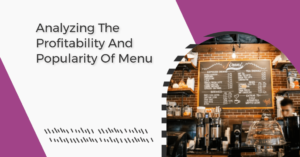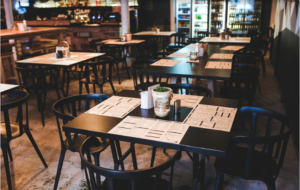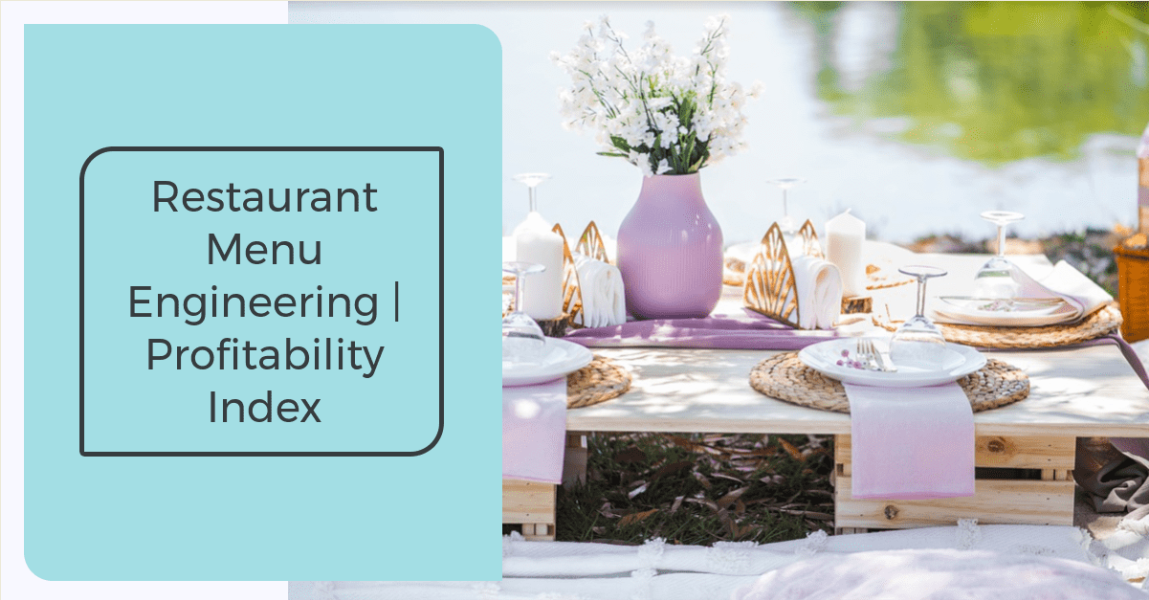Restaurant Menu Engineering refers to the analysis done to ascertain the profitability and popularity of menu items and how the two influence the menu. The objective is to boost profitability per guest. Whereas restaurant menu engineering is commonly mentioned in the framework of ordinary paper, the idea is equally appropriate to online menus, drink menus, specials menus, and board menus. In case you are selling items with unstable profitability and popularity levels, engineering your menu can help you to maximize your profits. Check out similar articles.
Analyzing The Profitability And Popularity Of Menu | Profit Impact
Well-executed original menu engineering takes us about a month to complete. Besides, it increases a restaurant’s profits by 10% to 15% progressively. On the other hand, the profit impact doesn’t stop there. Some restaurants call us in once a year to press further profits out of the same menu. Although the low-hanging fruit has previously been realized in these cases, we have always been able to extract further profit increases in the range of 10%.
The disparity between the more and less successful trials on restaurant menu engineering does not center on the type and size of the organization. However, the determining factors are the restaurant manager understands the process that executes changes. The restaurant industry has many low-hanging engineering profits that should be realized. Read more
Presentation On How To Increase Your Restaurant Revenue
Restaurant Menu Engineering | The Process
We have customized the craft of the restaurant menu engineering process into four steps as indicated below:
- Do menu costing.
- Categorize your menu items as per their revenue and status levels.
- Design the menu.
- Try out your new menu design.
1. Restaurant Menu Engineering | Costing
 Menu costing is the process of analyzing each item on the menu based on individual ingredients and determines exactly how much it costs to produce each of these items. Since the engineering process depends greatly on the profitability level of each menu item, organizations must cost their individual food menus.
Menu costing is the process of analyzing each item on the menu based on individual ingredients and determines exactly how much it costs to produce each of these items. Since the engineering process depends greatly on the profitability level of each menu item, organizations must cost their individual food menus.
It is important to note that the person who deals with menu costing is usually the best person to take charge of the restaurant menu engineering process. This is because he/she will be extremely experienced in the food costs of each menu item. Therefore, we recommend that someone in charge of the restaurant carry out the process of menu costing.
Regrettably, one of the major problems in the restaurant industry is that about 80% of don’t do menu costing while 5% cost their menus incorrectly. The motive behind the 80% is because menu costing consumes a lot of time. Unluckily there is no other way around that fact; hence you must work hard if you want to realize the benefits of a more gainful menu.
2. Restaurant Menu Engineering | Classification Of Items
The process of classifying each menu item allows you to determine how to utilize your menu engineering hard work. This process is further broken into three parts as follows:
a) Divide Your Menu Into “Categories” And “Sections”
The term “category” means how you classify your menu at the broadest level. The following are the most common categories: appetizers, entrees, desserts, and drinks. The most important thing is that the menu items in the various categories do not overlap and that the list creates meaning for your specific menu.
Now you can break down your categories into sections. You may define “section” in diverse ways depending on the content of your menu. The following are some common sections that are considered as Entree: vegetarian entrees, seafood entrees e.t.c. For drinks category: alcoholic and nonalcoholic drinks. Nevertheless, when describing your sections ensures that you separate distinct menu items from each other.
b) Group Your Menu Items According To The Four Quadrants
Scrutinize every menu item. Besides, using information from a recent period, place each item into one of the four quadrants:
- Stars – high-profit levels and high reputation
- Plow-horses – low-profit levels and high reputation
- Puzzles – high-profit levels and low reputation
- Dogs – low-profit levels and low reputation
c) Establish Menu Items In Each Quadrant
Using the profit/popularity data above determine how you prefer dealing with each of your menu items. You should look at the menu items graded by profitability and popularity at the category level first and then at the section level. Considering your data at the category level can assist you in deciding where to put the different sections of your menu. For instance, if steaks are your Stars, you may work harder to market the Meat entrees section). On the other hand, the section level enables you to establish how to promote menu items inside each menu section. Read more.
The decisions you make will emanate from a mixture of art and common sense. Furthermore, while every circumstance is unique, below is guidance on how to utilize the collected data:
- Stars – your menu should draw attention to your Stars.
- Plow-horses – you may create more profitable descriptions of these menu items. For example, soup or salad specials time and again fall into this category. You can turn such a special into a more profitable three salad sampler.
- Puzzle – make sure your servers are up-selling these items and scrutinize if customers like the taste of the items. You may decide to lower the prices to maximize sales hence produce higher general profits. You may think about reformulating items in this category.
- Dogs – while omitting such items may be the best option; you don’t have to omit everything in this category. You may reduce the emphasis on these items by only listing their names and prices on your menu. However, you don’t put in any additional effort to promote them.
Once you have accomplished this step, your restaurant menu engineering objectives are achieved and you are ready to commence the menu design phase. Check out similar posts.
3. Restaurant Menu Engineering | Design
 An element of the design process involves establishing the items you want to sell most (the Stars). However, it goes further than this and cannot be done with a simple checklist. When doing menu design it is important to consider your customer base. This involves which customers order which items, what motivates them to your organization. Is it a specific dish, cheap drinks, and atmosphere? On the other hand, do your customers go through your menu scrupulously besides other factors? Menu design doesn’t happen in a vacuum. Therefore, having such data informs how and when to apply specific menu design techniques.
An element of the design process involves establishing the items you want to sell most (the Stars). However, it goes further than this and cannot be done with a simple checklist. When doing menu design it is important to consider your customer base. This involves which customers order which items, what motivates them to your organization. Is it a specific dish, cheap drinks, and atmosphere? On the other hand, do your customers go through your menu scrupulously besides other factors? Menu design doesn’t happen in a vacuum. Therefore, having such data informs how and when to apply specific menu design techniques.
Some of the best practices that could turn your menu into a profit center.
a) Use Illustrations To Emphasize The Items You Would Like To Sell Most
You can use a variety of graphics to emphasize an item. For instance, inserting a box around it, placing a photograph or a drawing near it, or placing an asterisk close to it.
The following are some of the things to consider when using this technique:
- Space requirements – Highlight items to provide enough space to successfully promote their items.
- Frequency – as you increase the number of items that are highlighted with illustrations, the impact that they have on your bottom line will reduce and your menu may look messy.
- Photographs – using a photograph can increase sales of an item by 30% when there is just a single photograph on the page. However, the more illustrations you add, the poorer their impact and vice versa. On the other hand, photographs on a menu may demean the whole menu concept. For this reason, don’t use this technique in a high-end restaurant menu.
b) Avoid Listing Your Prices In A Right Hand Side Column Of Your Menu
This is the main problem experienced with restaurant menus. Placing your prices in a column makes customers focus on price and not food. This could guide them to select the cheapest item in the column.
As an alternative, put prices at least two spaces at the end of the item description using the same font size type as well as style. Besides, avoid using a dollar sign close to the price, as this can cause customers to reflect on money.
c) Take Advantage Of Your Menu Item Descriptions
Another common dilemma is the failure of the menu to have a description of an item reflecting its significance. For example, don’t write your $40 lobster with no description, and then write a whole paragraph about your $10 hamburger. It should always be vice versa.
Use descriptions to distinguish an item from the rest. Avoid just listing the ingredients; instead, use evocative writings that can attract the guest’s interest in an item.
Points out brand names in case your ingredients have items are manufactured by well-known and respected brands. They improve the perception of the quality of the item.
d) Acknowledge The Science To Listing Each Menu Items Per Section
Even though you may list appetizers and entrees vertically, one to six, the intensity of customer focus on each of the six positions doesn’t follow the same order. The initial few slots enjoy levels of significance that match up to their position in the list. However, all said and done, it is the last item on the list that attracts the most attention.
Lists should be short with fewer items in every section to a maximum of seven. Having more than seven items in a list produces an information burden for the customer. When this occurs customers are often accustomed to ordering the most common item. Regrettably, the most common menu items are inclined to not being the most profitable. In contrast, small lists are simple to navigate and lead to higher profitability. This is due to the procurement of soaring profit entrees and an elevated quantity of add-on items.
e)Take Advantage Of Menu Cover’s Arrangement
Not all menu cover arrangements are alike. They differ in the way customers respond to them and the degree to which they allow restaurant menu engineering to influence your profits.
Below is a list of several common menu cover arrangements and their effect on your menu engineering efforts:
- One-panel menu – make faster decisions with these menus. However, they won’t buy as much leading to lower profitability per client. The cause for this occurrence is that this menu cover arrangement does not stir up a full dining experience.
- Two-panel menu – whenever feasible, this is the best arrangement to use. It is simple to understand and provokes the strong emotions of a complete dining experience.
- Three-panel menu – this is a suitable choice if you have numerous items to sell and call for more space.
- Many-panel menu – the more menu panels the less control you have over the menu. Large menus hold back your capability to persuade customers’ actions.
f) Take Advantage Of Eye-Movement Patterns Of Your Customer
The eyes of your customers are inclined to focusing on specific areas of your menu based on the configuration on the cover. Take advantage of these patterns to put selected menu items in spots where they are probable to receive the most attention.
If you are promoting an expensive dish, you may avoid placing it as the highest focal point on the menu. Doing so might make your restaurant appear extremely expensive to the customer.
g) Think Beyond The Menu
Whereas restaurant menu engineering is accountable for your profit, some of your profits can emanate from enlightening your staff on priority menu items. They are directly involved with your customers, hence, very helpful in guiding customers to the most profitable or signature dishes.
4. Test Your New Menu Design
When dealing with large restaurant chains, use 10 to 90 outlets as test cases for the new menu. Regional chains are usually tested using a sole location. For single-unit processes, it is generally advised not to run a concurrent test of the new and old menus. This is because monitoring two sets of results from a single location can be complex.
The Bottom-Line
When designing a piece of free promotion you should ensure that it can be seen by your customers. Besides, there is always an opportunity for profit enhancement. Therefore, you should continually test your new menu designs more often.
Reach out for our hospitality consultancy services Here

Thanks for reading and sharing your thoughts about the content on the blog. I aspire to do my best by sharing vital information to the world. Your reviews are of great importance to me.
Thanks.